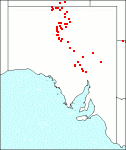Family: Amaranthaceae
Ptilotus parvifolius
Citation:
F. Muell., Fragm. Phyt. Aust. 6:229 (1868).
Synonymy: Trichinium parvifolium F. Muell., Rep. Babbage Exped. 1858 19 (1859); T. whitei J. Black, Trans. R. Soc. S. Aust. 38:464 (1914).
, Ptilotus parvifolius Common name: None
Description:
Young stems and branchlets pruinose; leaves ovate-lanceolate to spathulate, to 16 x 8 mm, bluish-green to greyish, often clustered; bracts to 6 mm long, lustrous; dorsal vestiture covering the perianth-segments, inner segments internally with a woolly beard; cupule densely pilose.
Spikes globose, to c. 3 cm diam., later cylindrical and to c. 6 cm long; greenish-white to lilac-purple, loosely flowered; perianth 9-15 mm long; perianth-segments bordered, with a median greenish area, all acute, sometimes inrolled, nearly free to the base; stamens purple, 2 rarely 3 fertile, cup almost free, hairy; ovary subclavate, glabrous, style lateral.
|
|
Distribution:
|
S.Aust.: LE, GT. W.Aust.; N.T.; Qld.
|
Conservation status:
native
Flowering time: throughout the year, mainly July — Jan.
|

SA Distribution Map based
on current data relating to
specimens held in the
State Herbarium of South Australia
|
Biology:
No text
Key to Infraspecific taxa:
|
1. Leaves greyish, to 16 mm long; bracts golden-yellow; perianth-segments hairy, with purplish to mauve tips |
|
var. parvifolius 19a. |
|
1. Leaves green, to 6 mm long; bracts stramineous; perianth-segments less hairy, bright-purple on glabrous apices and margins |
|
var. laetus 19b. |
Author:
Not yet available
|

